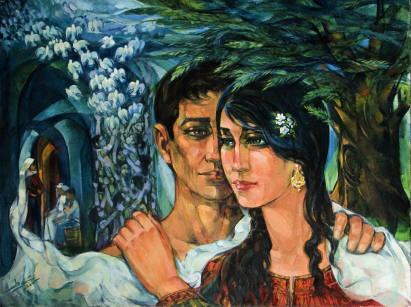 About a month ago, one of my friends inquired about the reason for my absence in the funeral procession of celebrated Egyptian artist and art critic Ahmed Fouad Selim. "Selim died two weeks ago," my friend, who is a painter, rebuked me. "I saw you nowhere. As far as I know you admired Selim, his critical essays and visions of art very much." Seconds passed before I could recover from the sad news. I confirmed to my friend that I did not know that Ahmed Fouad Selim had passed away. Nor did any of my friends in the art community had informed me. Perhaps
About a month ago, one of my friends inquired about the reason for my absence in the funeral procession of celebrated Egyptian artist and art critic Ahmed Fouad Selim. "Selim died two weeks ago," my friend, who is a painter, rebuked me. "I saw you nowhere. As far as I know you admired Selim, his critical essays and visions of art very much." Seconds passed before I could recover from the sad news. I confirmed to my friend that I did not know that Ahmed Fouad Selim had passed away. Nor did any of my friends in the art community had informed me. Perhaps
everybody, who were close to Selim, expected everybody else, had been informed of Selim's death and would take part in his funeral procession. After recovering, I blamed myself for stopping to visit Selim in his office in the Egyptian Museum of Modern Art or in his studio downtown. I had decided to cut short my visit after I was informed that the celebrated artist and art critic was attacked by a fatal disease and became too weak to extraordinarily lecture his audiences on modernism, post-modernism and the latest developments of art movement, locally and globally.The last time I saw him was about three months before his death. The brief meeting took place when I went to the Egyptian Museum of Modern Art in Gezira Ground to meet his faithful assistant and apprentice, artist Rasha Ragab, who was preparing a performance, in collaboration with a German colleague, in the Upper Egyptian city of Luxor. According to his habit, Selim was sitting at the meeting table overcrowded with books, catalogues, journals, papers, correspondences, etc. Rushing to shake hands with him, I slowed down my pace after realising that he was not as energetic as before. He was too weak; his hair became purely silver; and his looks less sharp than before. I knew Ahmed Fouad Selim in 1996, when he was looking for someone to translate his preface to the catalogue of Cairo Biennale. At first, his ideas, style of writing, the construction of sentences, artistic expressions, jargons and visions were too challenging to surmount. Appreciating my difficulty, he kindly agreed to arrange meetings in the Press Club in Monib, Giza, or in his studio to 'teach me how I can decode the message in modern art, appreciate the artist's technique, style and sources of inspiration'. The great artist also recommended several books and periodical interested in art.During our meetings, I discovered that Selim had an encyclopaedic mind; his knowledge of art, its history, developments and radical movements was immense. He also had strong connections with internationally celebrated art critics, who are widely regarded as theorists. Although he would sometimes be tough, edgy and irreconcilable, it never occurred to me to boycott him - he was a great art critic and mentor. Despite harsh attacks from his colleagues loyal to classical schools of art, Selim, a self-taught artist, had never let down his admirers and supporters. Selim motivated cultural relationships with foreign circles when he worked as cultural and art adviser for the Czechoslovak Cultural Centre in Cairo from 1967 to 74. He established the experimental 100-seat Theatre in 1968-1973, which selected 'the Rooster' as its logo. He played an undeniable role in nurturing the art movement in Egypt. Together with artists Ahmed Nawar, Moustafa el-Razaz and Mohsen Shaalan, he committed himself to giving Cairo a prestigious position in the map of internationally-famed capitals of art. He was one of enthusiastic campaigners in 1966 to establish the Association of Egyptian Artists. His colleagues at that time were artists Hamed Nada, Sayed Abdel Rasoul, Saleh Reda, Ramzy Mustafa and others. Their plan was fulfilled in 1976. The wall of Selim's studio is adorned with sketches, paintings - and certificates of merit he had received in acknowledgement of his contributions to art movement in Egypt. He was the first prize for painting in the 10th and 20th Alexandria Biennale of Mediterranean Countries in 1974 and 2000, the second prize in painting in Cairo Salon of Art in 1983, the Grand Nile Prize and Oscar "Ti", from the third International Cairo Biennale, (painting Installation), Chevalier l'ordre des Arts from the French government in 1986 and the Art Medal from the Queen of Denmark in 1986 - among many other prestigious prizes and awards. Selim is survived by his works, which are part of art collections in major art museums and institutions in different countries.



